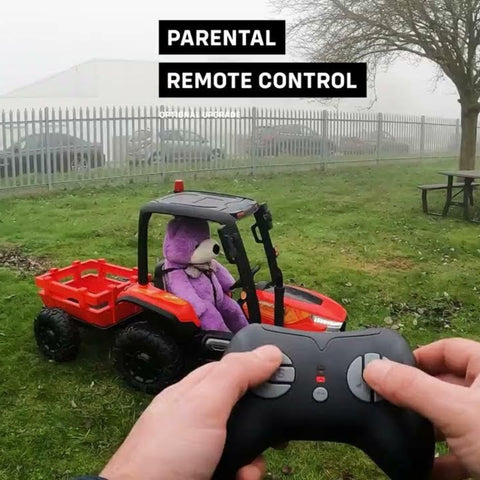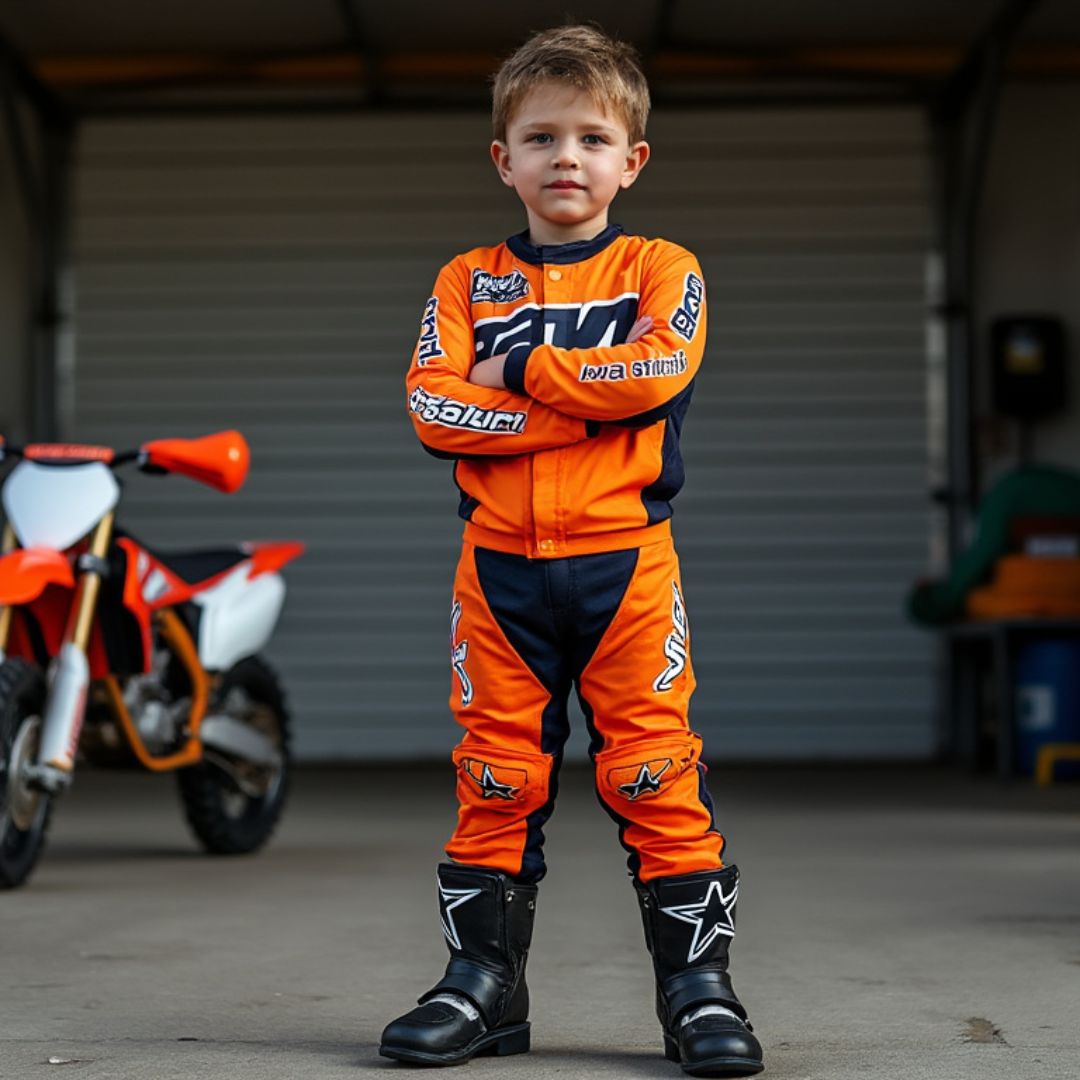
Imagine this: little Alex climbs onto his new ride-on tractor for the first time, his eyes wide with excitement.
As the wheels begin to turn, so does a spark of independence in his young mind.
Ride-on tractors are more than just toys; they're tools that help cultivate essential skills in children from a young age.
These miniature vehicles not only provide hours of fun but also play a crucial role in developmental milestones.
In fact, studies have shown that engaging with such interactive toys can significantly boost motor skills and creativity in children.
Safety First: Ensuring Fun is Also Safe
Before we dive into the many benefits of these charming vehicles, let’s talk about safety. It's paramount to ensure that playtime remains safe.
Parents should look for ride-on tractors equipped with features like seat belts, sturdy construction, and speed controls.
It’s also vital to supervise young riders and establish clear boundaries for where and how the tractor can be used.
Helmets and closed-toe shoes are must-haves to protect little adventurers as they explore.
Age-Appropriate Tractors
Selecting a ride-on tractor that's appropriate for your child’s age and size is crucial for safety and enjoyment.
For toddlers and younger children (ages 2-4), look for tractors with simple controls, low speeds, and sturdy construction.
These models are usually smaller and easier to operate.
As children grow older (ages 5-7), they can handle slightly larger tractors with more features, like adjustable seats and pedals, which grow with them.
For children over eight years, you can consider even more advanced models that can accommodate higher weights and provide more power.
Always check the manufacturer’s recommended age and weight limits to ensure the tractor is a good fit for your child.
Ensuring the tractor is age-appropriate not only keeps your child safe but also makes it more likely that they'll be able to use it independently and confidently.
The Benefits of Ride-On Tractors for Children
Promotes Imaginative Play
When children hop onto their ride-on tractors, they're not just driving a toy; they're stepping into the boots of a farmer or a construction worker.
This type of imaginative play is a fantastic canvas for creativity, allowing kids to craft stories and adventures that broaden their understanding of the world around them.
Develops Motor Skills
Operating a ride-on tractor involves steering, pedalling, and navigating.
These activities are excellent for enhancing hand-eye coordination, balance, and spatial awareness.
As children learn to manoeuvre their tractors around obstacles in the backyard, they are not just playing; they are tuning their fine motor skills in a practical, enjoyable way.
Boosts Confidence
There’s a significant boost in self-esteem that comes from mastering the controls of a ride-on tractor.
Each ride gives children a sense of achievement and reinforces their ability to tackle new challenges.
This confidence can spill over into other areas of life, helping them face new situations with bravery and enthusiasm.
Encourages Physical Activity
In the digital age, finding fun and engaging ways to encourage physical activity is crucial.
Ride-on tractors get kids moving outdoors, driving them to physical health and fostering a love for active play.
Choosing the Right Tractor: Manual vs. Electric
When deciding between a manual and an electric ride-on tractor for your child, several factors come into play.
Manual tractors are typically pedal-powered and require physical effort, making them a great choice for encouraging exercise and physical development.
They're usually simpler, with fewer mechanical parts, which can mean less maintenance and a lower cost.
On the other hand, electric tractors are battery-operated and offer a more realistic driving experience with little physical effort needed.
They can be ideal for children who are not as physically inclined or for those who enjoy a longer ride without getting tired.
Electric models often come with more features, like working headlights, sounds, and even a radio, which can enhance playtime.
However, they do require charging and more complex maintenance.
Both types have their merits, so consider your child's age, physical ability, and interest level.
Younger children might benefit from the simplicity of a manual tractor, while older kids might appreciate the additional features that come with an electric model.
Building Independence
Ride-on tractors offer more than just fun—they are a child’s first taste of independence.
As children decide which path to take in the garden or how to navigate around a makeshift obstacle course, they are making decisions on their own.
This fosters a sense of responsibility and problem-solving skills.
For parents, it's about finding the balance between supervision and giving children the space to explore.
Setting up safe play areas and gradually allowing more freedom can significantly develop a child's autonomy.
Environmental Considerations
In today’s eco-conscious world, considering the environmental impact of a child’s ride-on tractor can be as important as any safety feature.
Electric tractors, while convenient and exciting, consume energy and require batteries that have a limited lifespan and need proper disposal.
Opting for models that use rechargeable batteries can help reduce waste.
For those seeking a more sustainable option, manual tractors don't require electricity, making them environmentally friendly and energy-efficient.
They also provide a great way for children to get physical exercise.
Whichever type you choose, consider how you can minimize its environmental impact.
For instance, if you go with an electric model, you can opt for energy-efficient batteries and ensure they are properly recycled at the end of their lifespan.
Also, maintaining and caring for the tractor to extend its usability can significantly reduce environmental waste, aligning playtime with eco-responsibility.
Encouraging Cooperative Play
Though often enjoyed solo, ride-on tractors can also be a conduit for cooperative play.
Organising playdates where children can share the tractor, take turns, or engage in tractor-themed games promotes teamwork and helps develop communication skills.
These activities teach children the value of working together and respecting others' turns, enhancing social interactions.
Maintenance and Care: Learning Responsibility
Maintaining a ride-on tractor can be as educational as it is necessary.
Simple tasks like wiping down the tractor, checking its parts, and proper storage can be a great way for children to learn about caring for their belongings.
Involving them in this process not only teaches them about maintenance but also instils a sense of pride and responsibility.
Conclusion
Ride-on tractors are a brilliant tool for growth, offering more than just entertainment—they prepare children for life's challenges by building independence, confidence, and cooperation.
As a parent, embracing these playful learning experiences can make a significant difference in your child's development.
So why not step outside, tractor in tow, and watch your little one pave their path to growth and independence?
Witness the joy as they explore, learn, and, most importantly, have a blast!
FAQs
What are some practical ways to introduce my child to their first ride-on tractor?
Introducing your child to their first ride-on tractor can be an exciting milestone. Start by choosing a safe environment with plenty of flat, open spaces where they can explore without obstacles. Demonstrate how the tractor works and guide them through the basic operations like moving forward, turning, and stopping. Initially, walk alongside them, offering encouragement and guidance. As they gain confidence, gradually step back and allow them more space to navigate independently, ensuring they remain safe. This hands-on approach helps children feel supported as they learn and grow more confident in their abilities.
How can ride-on tractors help in my child’s social development?
Ride-on tractors can be an excellent tool for enhancing your child's social skills. These toys encourage children to play cooperatively, especially when siblings or friends also play outdoors. Children learn important social skills like sharing, negotiating, and teamwork by sharing the tractor, taking turns, and even creating games that involve tractor riding. These interactions can help children understand social dynamics in a fun and engaging way, contributing significantly to their emotional and social development.
Are there specific times or situations where using a ride-on tractor would benefit my child’s development?
Using a ride-on tractor can be particularly beneficial during your child's early developmental stages when they learn to assert their independence and enhance their motor skills. Integrating tractor play into regular outdoor activities can help develop these skills. For example, using the tractor during a playdate provides a social context, while setting up obstacle courses or tasks can challenge their problem-solving abilities and encourage creative thinking. Regular, structured playtimes with the tractor also help establish a routine where children can look forward to and prepare for an activity, aiding in their cognitive and emotional development.
Get in Touch 🚀
Loved our article on “Building Independence with Kids Ride-On Tractors” Got the itch to dive into more wheely-awesome info?
Whether you're a parent or a grandparent, we're here for all your kids ride-on toy questions! 🚗💨
Feeling click-happy?
Jump straight into our wonderland at RiiRoo.com.
Or, if you're more the chatty type, give our Live Chat a whirl and let's talk toys!










Share:
How to Create a Safe Riding Environment for Ride-On Tractors
Building a Home Obstacle Course for Kids Ride-On Tractors